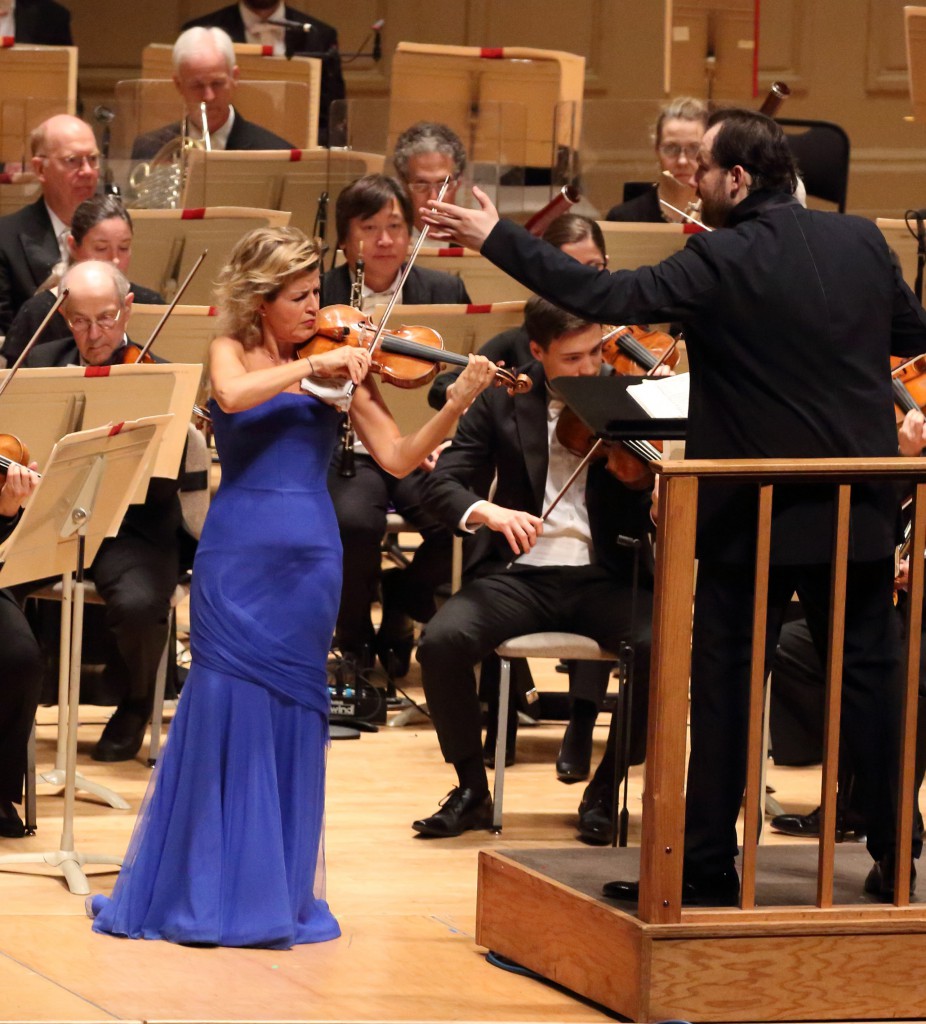Nelsons, BSO mark a Shostakovich milestone; Mutter plays two

Anne-Sophie Mutter performed music of Takemitsu and Tchaikovsky with Andris Nelsons and the Boston Symphony Orchestra Thursday night. Photo: Hilary Scott
The first installment of the Boston Symphony Orchestra’s Shostakovich cycle drew to a powerful conclusion Thursday night at Symphony Hall. Covering the composer’s Fifth through Tenth Symphonies, the multi-season project has resulted in rewarding performances and recordings, earning the orchestra and Andris Nelsons back-to-back Grammy Awards. With Nelsons’ contract being extended to 2022, there is ample time for more of these works, and next season the Latvian conductor will lead the Eleventh and Fourteenth Symphonies.
The Sixth Symphony, heard Thursday night, is one of Shostakovich’s most unusual works. In structure it is shorter than the Fifth and monumental Seventh, clocking in at about thirty minutes. The work also offers an inversion of the traditional symphonic form. The first movement is a stirring, melancholy Largo, which, as Leonard Bernstein has observed, seems to pick up where the final movement of Tchaikovsky’s Pathétique Symphony left off. The remaining movements are imbued with the composer’s characteristically wry humor.
Nelsons has proven a first-rate conductor of Shostakovich’s music, and he drew playing of deep mystery Thursday night. The opening phrases were a journey from darkness to light. Cello lines transformed into silvery passages taken over by the violins. Thomas Rolfs’ trumpet peeked out of the texture light sunshine through clouds. The first movement, too, bears references to Mahler, especially in the chamber-like sections. The BSO winds and strings handled them with precision and delicacy.
The ensuing movements offered a sharp contrast. The Scherzo was bright and beaming, its witty lines building to raucous climaxes. The final movement took off at a healthy gallop, with the BSO musicians playing with the verve of a circus band that brought the work to a rousing conclusion.
Fine playing also marked the short opener, Shostakovich’s Festive Overture. The brasses were stellar and sounded out the fanfares with bold power. The fast section moved with whip-crack speed, and even the long line of the second theme managed to sing through the brisk tempo. As with the shattering performance of the Leningrad Symphony earlier this year, these performances should make a fine future recording.
Filling out the remainder of the program were works for violin and orchestra that featured Anne-Sophie Mutter as soloist.
Takemitsu’s Nostalghia was written in memory of Soviet filmmaker Andrei Tarkovskij. Composed in 1987, the fifteen-minute work is one of searching power. The piece, too, presents extended techniques as almost Neo-romantic gestures for an effect that is haunting. String figures coalesce in sheets of sound that hang in the air like light through a church window. The solo part is less a spotlight than a commentary on the orchestral line. Mutter’s chromatic passages, played with smooth, shimmering tone, evaporated into a halo of harmonics. Elsewhere her playing was colorful, with lines sounding silvery, radiant, and warmly resonant by turns.
Her performance of Tchaikovsky’s Violin Concerto was similarly colorful. The principal theme of the first movement featured her in a tone laced with amber. In the fiery passagework, which she played with aplomb, her sound took on a slight edge to give the music a rapt intensity. The second movement flowed in soft arcs. Mutter’s flute-like lines were finely matched to Tchaikovsky’s orchestral writing, and woodwinds and horns sounded reverential in the closing passages.
The finale was sharp and driving, the principal theme taking off with crackling energy. Mutter’s playing of the second theme moved with a songlike freedom to the line, and Nelsons led an accompaniment well attuned to her phrasing. Textures were soft and elegantly balanced. Quick passages blazed with excitement where appropriate. The nimble ending, played with a classical delicac managed to bring the audience to its feet.
The program will be repeated 8 p.m. Friday, Saturday, and Tuesday at Symphony Hall. bso.org; 888-266-1200.
Posted in Performances
Posted May 04, 2017 at 2:58 pm by tama zorn
The Shostakovich pieces were marvels of orchestral dexterity and passion. The Tchaikovsky, particularly the first movement, was drab and colorless and lacked all Russian soul. Listen to someone else play this (Perlman or Heifitz) and hear it as it is meant to sound.